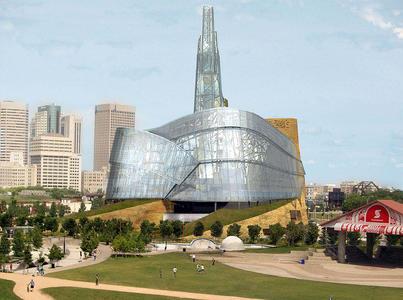The Canadian Human Rights Museum in Winnipeg is set to open sometime in 2013, and the inaugural suite of exhibits is being prepared now. How are decisions about how lesbian and gay people are represented in the final product being made?
A 17-member content advisory committee (CAC) toured the country to gather stories on human rights and produced a report intended to shape the museum’s content. The CAC’s mandate ended in April of 2010.
“It was a good process,” says Jennifer Breakspear, committee member and executive director of Qmunity in Vancouver. “Given the restrictions of time, expense and the sheer size of this country and the scope of human rights issues, it’s really hard to feel that you got it all. I feel that we did good work, and I feel that we put forward a good report, but we could have done that work for years, touring the country and talking to Canadians about human rights.”
Breakspear visited Whitehorse, Yellowknife, Calgary, Edmonton and Vancouver with the CAC. Aside from smaller meetings, there were also publicized community round-table sessions at which members of the public discussed human rights issues and asked questions about the museum’s development.
“Given that I was asked to join the committee because of my involvement in the queer community, it was important to me that we make sure that there were invitations out to representatives of the queer community across the country, that we got trans representation, that we made sure that our community was heard from, and I think it was,” Breakspear says.
One of the groups that met with the CAC is Vancouver’s Rainbow Refugee Committee. A member of that committee, Sharalyn Jordan, and Chris Morrissey, of LEGIT (Lesbian and Gay Immigration Task Force), spoke about the experiences of queer refugees coming to Canada.
“What impressed me about it specifically was that they were interested in the story of how ordinary Canadians impacted human rights law and practice in Canada,” says Jordan. “There was certainly some question about how do we present this material in a way that will be understandable and accessible to school kids, because that’s some of who will be coming through.”
Breakspear says the focus on grassroots organizations was meant to ensure that their voices were heard in the process, and not only those of larger organizations like Egale Canada.
“It was more about making sure that we hear from folks on the ground,” says Breakspear. “It would be easy to not hear them, and we didn’t want to miss that.”
Breakspear also notes that museum administrators paid particular attention to the input of queer communities as part of the consultation process. At one point, Breakspear was called on to help find more people to speak to when sessions in Eastern Canada didn’t have as many queer voices lined up as administrators had hoped.
“There certainly was not just a willingness but a support from within the museum staff to make sure that our community was represented in the consultations,” Breakspear says.
The final CAC report contains a section on queer issues that addresses the grassroots activism that helped keep social spaces like clubs and bathhouses from being closed, and mounting legal challenges with cases like the Vriend decision. The section on the role of history also makes mention of “the homophobia that sought to inculcate a compulsory heterosexuality in all Canadians.”
“We feature [queer] content throughout the museum, so it’s not really in one specific area, but it really is subject matter that we feel is very important to run as a kind of current throughout the museum,” says Dr Rhonda Hinther, head of research and curation at the museum.
Hinther says topics they will be looking at include resistance to discrimination against the queer community, grassroots activism in the ’50s, ’60s and ’70s, the movements that demanded rights, and exhibits on same-sex marriage rights.
“We have an exhibit on refugees that deals with the experiences of queer refugees to Canada,” Hinther says. “We have portions of our exhibition on the Holocaust, which deals with the experiences of gays and lesbians. And we have another gallery, which looks at the codification of human rights within Canada, and within that we’re going to be looking at the experiences of the Little Sister’s bookstore as a case study.”
Hinther says there will also be opportunities for queer-themed programming or special events in the future. As exhibits are developed, museum administrators will again consult with a CAC, of which Egale Canada’s Helen Kennedy is a member.
“My role on that advisory council is to make sure that at every juncture, [queer] issues are part of the discussion,” she says.
“My role is to say, ‘Oh, you forgot trans issues here. How are we going to address that? What are we going to do?’” Kennedy says. “We’re there to offer advice and say, ‘Maybe you should look at that from a different perspective.’”
Part of Hinther’s work is to collect recorded oral histories. The goal is to develop a unique Canadian collection that not only informs the museum exhibits, but that will form a valuable part of the research archive.
“We need somewhere to tell these stories, and we need to make sure that we reach as many Canadians as possible and we hear as many of these stories as possible,” says Breakspear. “The challenge is for the museum people to find a way to present the stories and cycle them through, because it won’t be a static museum. It’ll have to be always changing.”
According to Angela Cassie, a museum spokesperson, there is an emphasis on collecting interactive and participatory content, rather than simply a series of static dioramas.
“Because there are a lot of stories of violation and a lot of stories that focus on these negative chapters in history, people have an impression that they’re going to come away with this ‘saddest place on earth’ characterization,” Cassie says.
The museum will instead, she says, aim to inspire and engage visitors.
“When we’re looking at what we’re developing, it’s looking at those examples of resilience, of perseverance, of people who organized and challenged these things and didn’t remain silent,” Cassie says. “We really want to be able to inspire people.”


 Why you can trust Xtra
Why you can trust Xtra


